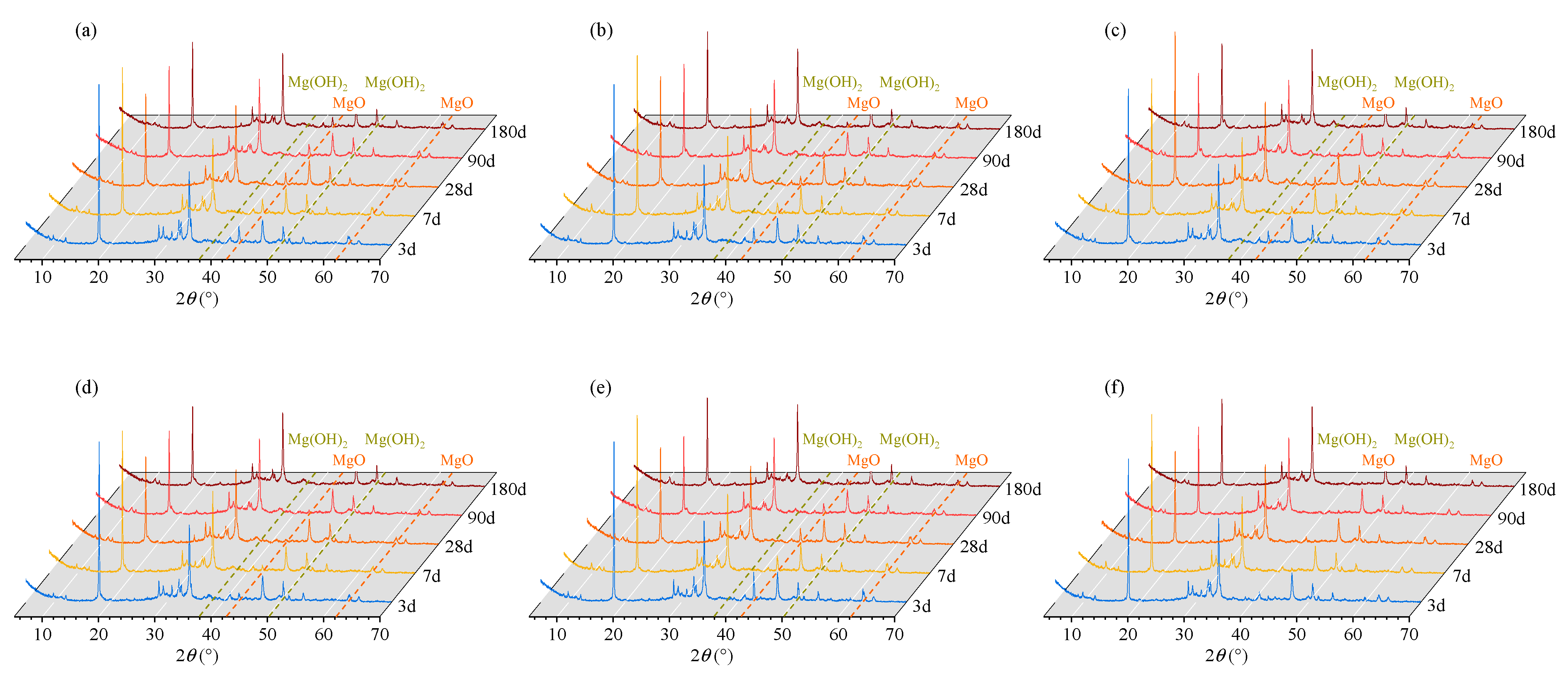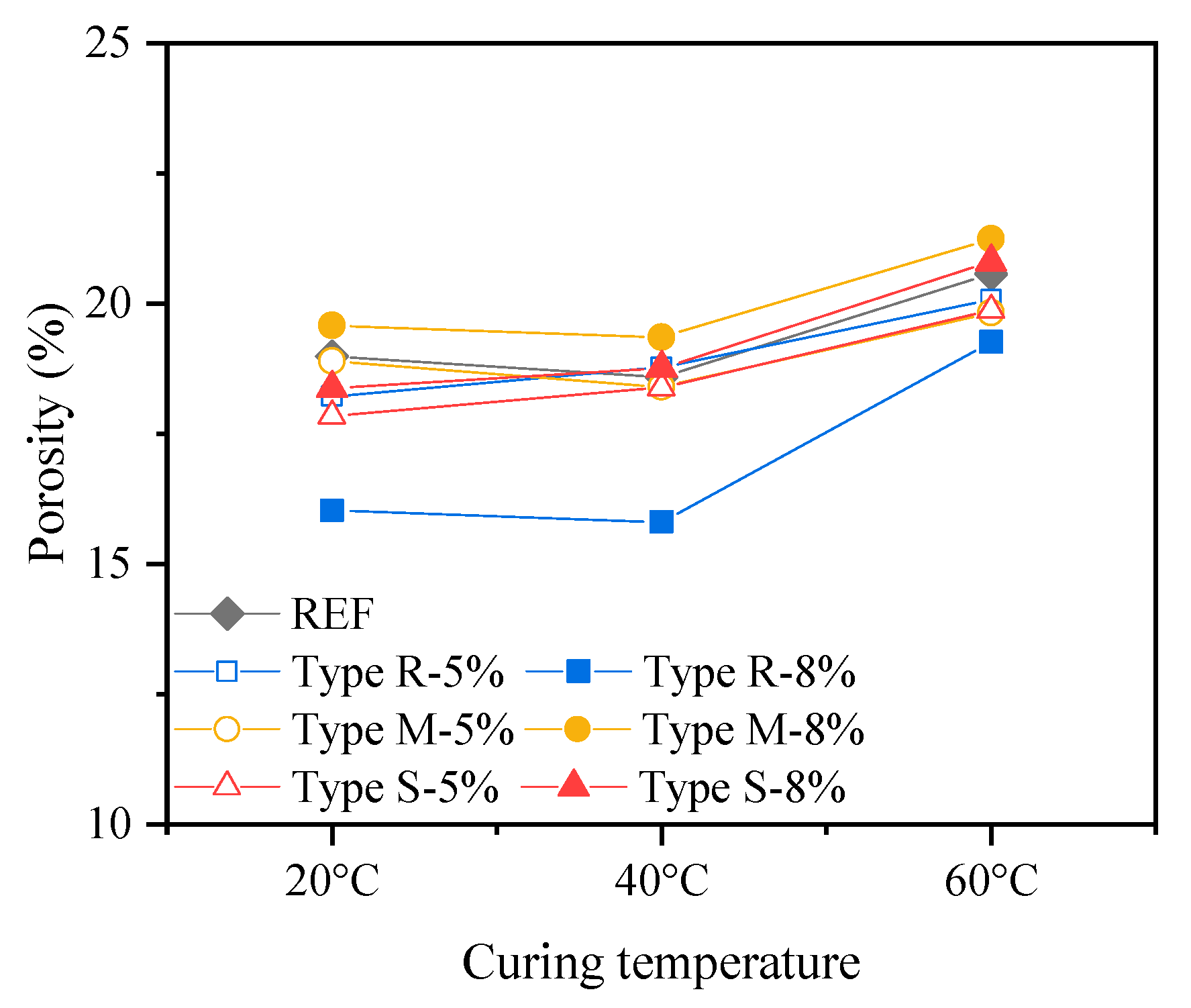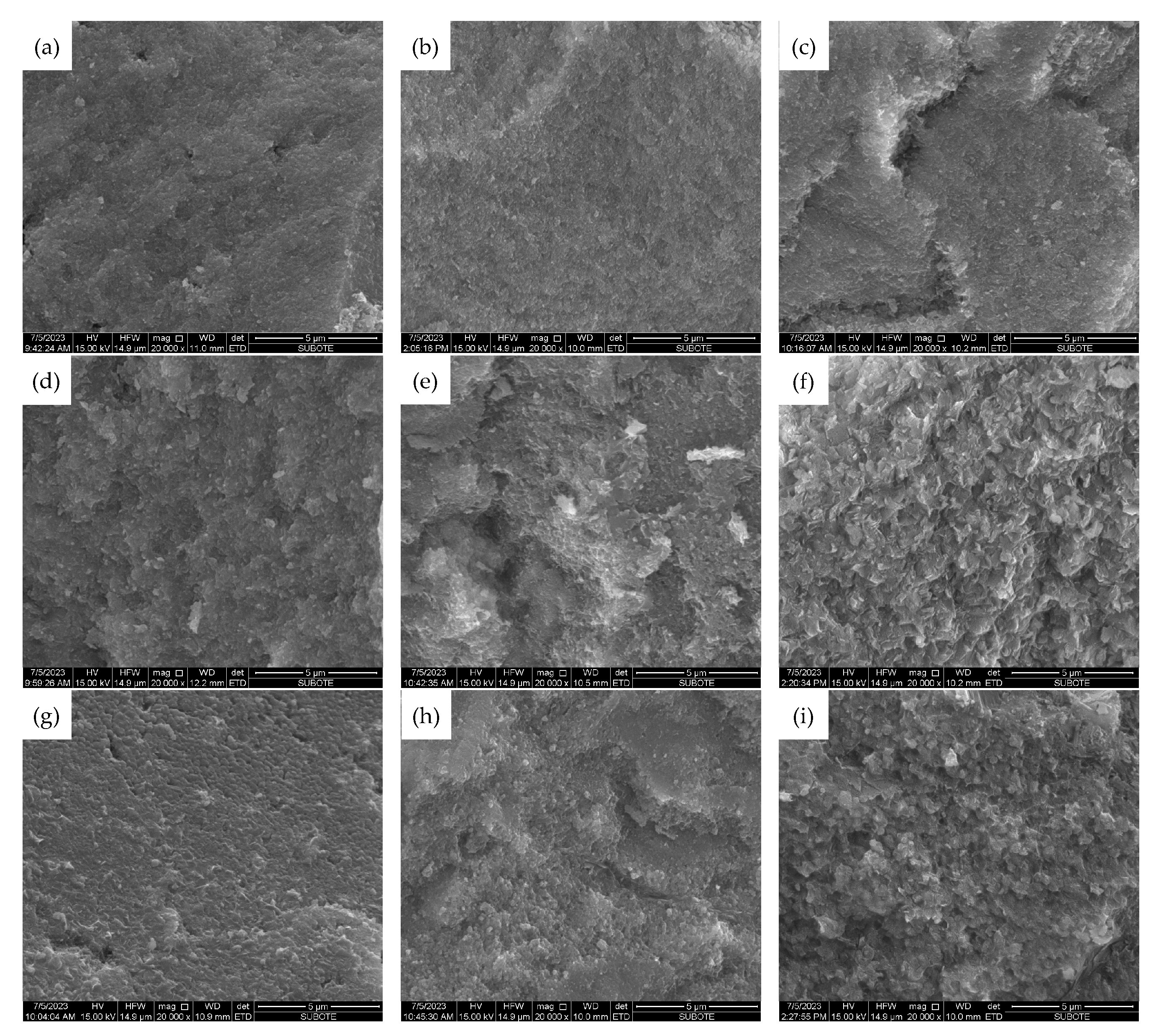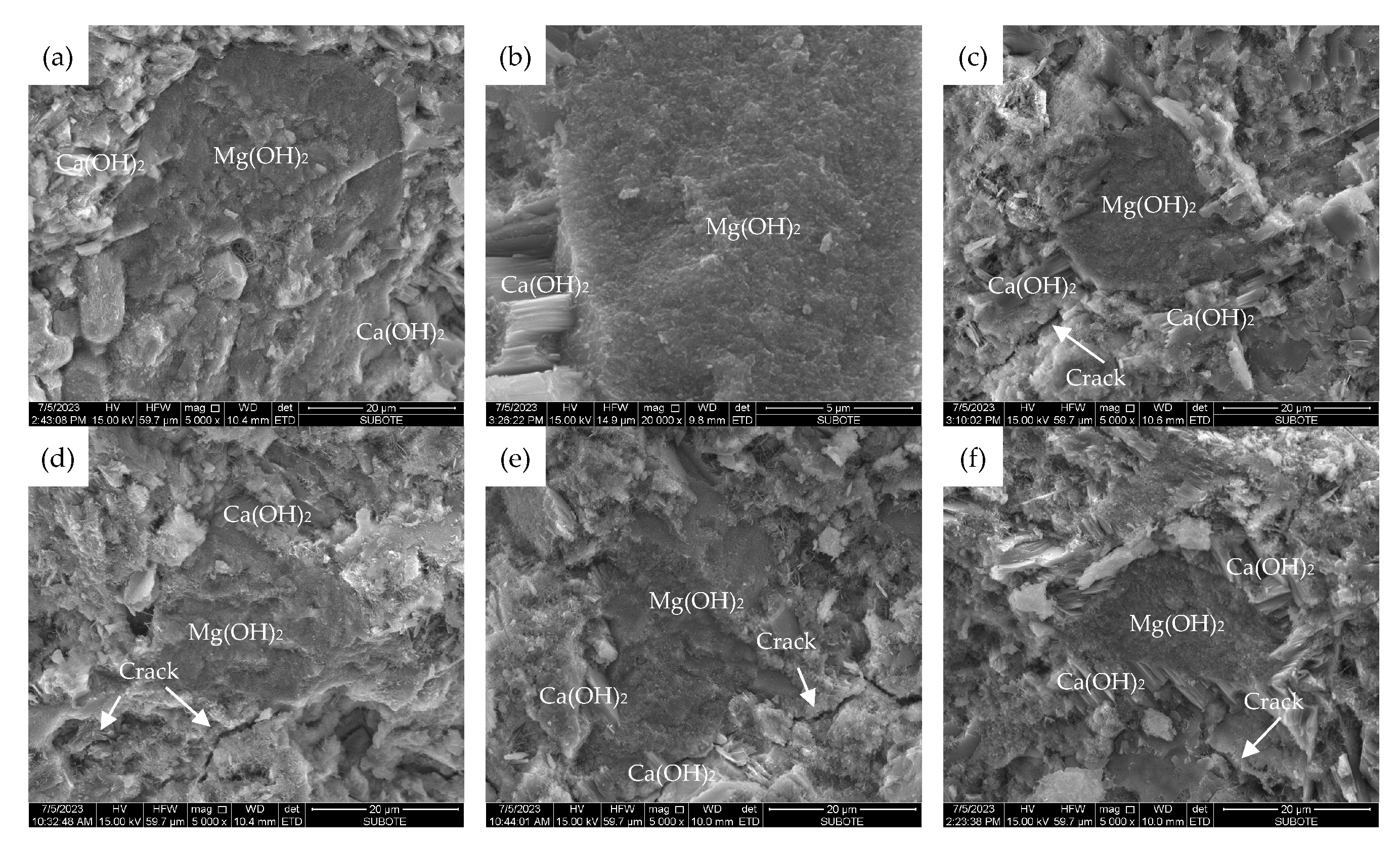Effects of MEA Type and Curing Temperature on the Autogenous Deformation, Mechanical Properties, and Microstructure of Cement-Based Materials
Abstract
:1. Introduction
2. Materials and Methods
2.1. Raw Materials
2.2. Test Methods
3. Results and Discussion
3.1. Autogenous Deformation and Mechanical Properties of Cement-Based Materials Containing MEA
3.1.1. Autogenous Deformation Properties
3.1.2. Mechanical Properties
3.2. Hydration Behavior of MEA in Cement-Based Materials
3.3. Microstructure of Cement-Based Materials Containing MEAs
3.3.1. Pore Structures
3.3.2. SEM Micromorphology
4. Conclusions
Author Contributions
Funding
Data Availability Statement
Conflicts of Interest
References
- Zhao, S.Z.; You, B.K. Cracking and Seepage Control Technology and Application of Shrinkage-Compensating Concrete; China Architecture and Building Press: Beijing, China, 2010; pp. 184–219. (In Chinese) [Google Scholar]
- You, B.K. On the application scope of concrete expansive agent. Concrete 2002, 9, 8–9. (In Chinese) [Google Scholar]
- Yan, P.; Zheng, F.; Peng, J.; Qin, X. Relationship between delayed ettringite formation and delayed expansion in massive shrinkage-compensating concrete. Cem. Concr. Compos. 2004, 26, 687–693. [Google Scholar] [CrossRef]
- Zhou, Q.; Lachowski, E.E.; Glasser, F.P. Metaettringite, a decomposition product of ettringite. Cem. Concr. Res. 2004, 34, 703–710. [Google Scholar] [CrossRef]
- Wang, X. Comparison Study on the Expansion Performance of MgO-Based Expansive Additive and Etrringite-Based Expansive Additive. Master’s Thesis, Nanjing University of Technology, Nanjing, China, 2006. (In Chinese). [Google Scholar]
- Mo, L.; Deng, M.; Tang, M.; Al-Tabbaa, A. MgO expansive cement and concrete in China: Past, present and future. Cem. Concr. Res. 2014, 57, 1–12. [Google Scholar] [CrossRef]
- Sherir, M.A.A.; Hossain, K.M.A.; Lachemi, M. Self-healing and expansion characteristics of cementitious composites with high volume fly ash and MgO-type expansive agent. Constr. Build. Mater. 2016, 127, 80–92. [Google Scholar] [CrossRef]
- Qureshi, T.; Kanellopoulos, A.; Al-Tabbaa, A. Autogenous self-healing of cement with expansive minerals-II: Impact of age and the role of optimised expansive minerals in healing performance. Constr. Build. Mater. 2019, 194, 266–275. [Google Scholar] [CrossRef]
- Cao, Z.S.; Xu, J.H. Construction Technology of Dam with MgO Concrete; China Electric Power Press: Beijing, China, 2003; pp. 161–196. (In Chinese) [Google Scholar]
- Chen, C.L.; Shen, X.P.; Chen, X.M. Application of damming technology with MgO admixed concrete used in the whole dam in Guizhou’s arch dam projects. Adv. Sci. Technol. Water Resour. 2017, 37, 84–88+94. (In Chinese) [Google Scholar]
- Huang, K.; Deng, M.; Mo, L.; Wang, Y. Early age stability of concrete pavement by using hybrid fiber together with MgO expansion agent in high altitude locality. Constr. Build. Mater. 2013, 48, 685–690. [Google Scholar] [CrossRef]
- Li, H.; Tian, Q.; Zhao, H.; Lu, A.; Liu, J. Temperature sensitivity of MgO expansive agent and its application in temperature crack mitigation in shiplock mass concrete. Constr. Build. Mater. 2018, 170, 613–618. [Google Scholar] [CrossRef]
- Li, M.; Xu, W.; Wang, Y.; Tian, Q.; Liu, J. Shrinkage crack inhibiting of cast in situ tunnel concrete by double regulation on temperature and deformation of concrete at early age. Constr. Build. Mater. 2020, 240, 117834. [Google Scholar] [CrossRef]
- Mo, L.W.; Deng, M.; Tang, M.S. Effects of calcination condition on expansion property of MgO-type expansive agent used in cement-based materials. Cem. Concr. Res. 2010, 40, 437–446. [Google Scholar] [CrossRef]
- Wang, G.Y.; Deng, M.; Mo, L.W.; Chu, Y.T. Influences of magnesite grade on component, microstructure and property of MEA. J. Mater. Sci. Eng. 2014, 32, 658–664. (In Chinese) [Google Scholar]
- Liu, J.; Wang, Y.; Tian, Q.; Zhang, S. Temperature sensitivity of light calcined magnesia expansion agent and its mechanism analysis. J. Southeast Univ. 2011, 41, 359–364. (In Chinese) [Google Scholar]
- Cao, F.Z.; Yan, P.Y. Influence of chemical activity and curing temperature on expansion properties of magnesium oxide expansive agents. J. Chin. Ceram. Soc. 2017, 45, 1088–1095. (In Chinese) [Google Scholar]
- Mo, L.; Fang, J.; Hou, W.; Ji, X.; Yang, J.; Fan, T.; Wang, H. Synergetic effects of curing temperature and hydration reactivity of MgO expansive agents on their hydration and expansion behaviours in cement pastes. Constr. Build. Mater. 2019, 207, 206–217. [Google Scholar] [CrossRef]
- Zhou, X.; Mao, Z.Y.; Luo, P.H.; Deng, M. Effect of mineral admixtures on the mechanical and shrinkage performance of MgO concrete. Materials 2023, 16, 3448. [Google Scholar] [CrossRef]
- Cui, Y.; Wang, H.; Liu, K.S.; Wang, Q. Rheological, deformation behaviors and mechanical changes of MgO-containing concretes with different strength. J. Build. Eng. 2023, 64, 105593. [Google Scholar] [CrossRef]
- Cao, Y.H.; Deng, M.; Mo, L.W. Performance of C70 concrete mixed with MgO-based expansive agent in outdoor exposure conditions. Concrete 2013, 10, 62–65. (In Chinese) [Google Scholar]
- Tian, W.; Peng, G.; Liang, H.; Chen, X.Q. Study on mechanical properties of micro-expansion concrete mixed with MgO. Concrete 2015, 9, 24–26+30. (In Chinese) [Google Scholar]
- Li, C.M.; Chen, X.M. Temperature effect test of mechanics property of concrete mixed with MgO. Water Power 2006, 32, 31–33+37. (In Chinese) [Google Scholar]
- Yang, F.L.; Ji, Y.H.; Jin, X.L.; Qian, Y.D.; Geng, C.S. Effects of magnesium oxide expansive agents on concrete property under engineering temperature condition. Concrete 2019, 1, 110–113+117. (In Chinese) [Google Scholar]
- Wang, A.; Deng, M.; Sun, D.; Mo, L.; Wang, J.; Tang, M. Effect of combination of steel fiber and MgO-type expansive agent on properties of concrete. J. Wuhan Univ. Technol. 2011, 26, 786–790. [Google Scholar] [CrossRef]
- Li, S.; Mo, L.; Deng, M.; Cheng, S. Mitigation on the autogenous shrinkage of ultra-high performance concrete via using MgO expansive agent. Constr. Build. Mater. 2021, 312, 125422. [Google Scholar] [CrossRef]
- Liu, J.P.; Wang, Y.J.; Tian, Q.; Zhang, S.Z. Modeling hydration process of magnesia based on nucleation and growth theory: The isothermal calorimetry study. Thermochim. Acta 2012, 550, 27–32. [Google Scholar] [CrossRef]
- Thomas, J.J.; Musso, S.; Prestini, I. Kinetics and activation energy of magnesium oxide hydration. J. Am. Ceram. Soc. 2014, 97, 275–282. [Google Scholar] [CrossRef]
- Rodríguez-Álvaro, R.; González-Fonteboa, B.; Seara-Paz, S.; Hossain, K.M. Internally cured high performance concrete with magnesium based expansive agent using coal bottom ash particles as water reservoirs. Constr. Build. Mater. 2020, 251, 118977. [Google Scholar] [CrossRef]
- Deng, M.; Cui, X.H.; Liu, Y.Z.; Tang, M.S. Expansion of mechanism of MgO in cement. J. Nanjing Inst. Chem. Technol. 1990, 12, 1–11. (In Chinese) [Google Scholar]
- Amaral, L.F.; Oliveira, I.R.; Salomão, R.; Frollini, E.; Pandolfelli, V.C. Temperature and common-ion effect on magnesium oxide (MgO) hydration. Ceram. Int. 2010, 36, 1047–1054. [Google Scholar] [CrossRef]
- CBMF 19-2017; Magnesium Oxide Expansive Agent for Concrete. Standard of China Building Materials Association: Beijing, China, 2017. (In Chinese)
- DL/T 5296-2013; Technical Specification of Magnesium Oxide Expansive for Use in Hydraulic Concrete. Industry Standards of the People’s Republic of China: Beijing, China, 2013. (In Chinese)
- GB 8076-2008; Concrete Admixtures. National Standard of the People’s Republic of China: Beijing, China, 2008. (In Chinese)
- ISO 679-2009; Cement—Test Methods—Determination of Strength. International Standard: Geneva, Switzerland, 2009.
- JGJ/T 70-2009; Standard for Test Method for Performance on Building Mortar. Industry Standards of the People’s Republic of China: Beijing, China, 2009. (In Chinese)
- Li, H.; Liu, J.; Wang, Y.; Tian, Q. Simplified chemo-mechanical model of hydration/expansion of calcium-oxide-type expansive agent in cement-based materials. Mag. Concr. Res. 2020, 72, 1006–1015. [Google Scholar] [CrossRef]
- Lothenbach, B.; Winnefeld, F.; Alder, C.; Wieland, E.; Lunk, P. Effect of temperature on the pore solution, microstructure and hydration products of Portland cement pastes. Cem. Concr. Res. 2007, 37, 483–491. [Google Scholar] [CrossRef]
- Lin, M.; Itoh, M.; Maruyama, I. Mechanism of change in splitting tensile strength of concrete during heating or drying up to 90 °C. J. Adv. Concr. Technol. 2015, 13, 94–102. [Google Scholar] [CrossRef]
- GB/T 176-2017; Methods for Chemical Analysis of Cement. National Standard of the People’s Republic of China: Beijing, China, 2017.













| Index | Type R | Type M | Type S | |
|---|---|---|---|---|
| Reactivity Value (s) | 55 ± 5 | 150 ± 10 | 220 ± 10 | |
| Chemical compositions (XRF, mass-%) | MgO | 89.16 | 90.40 | 91.38 |
| CaO | 1.86 | 2.13 | 2.21 | |
| SiO2 | 3.66 | 3.89 | 3.86 | |
| Al2O3 | 0.76 | 0.71 | 0.63 | |
| Fe2O3 | 1.00 | 1.07 | 0.95 | |
| SO3 | 0.04 | 0.03 | 0.02 | |
| K2O | 0.04 | 0.06 | 0.04 | |
| Na2O | 0 | 0 | 0 | |
| TiO2 | 0.02 | 0.01 | 0.02 | |
| P2O5 | 0.07 | 0.09 | 0.08 | |
| MnO | 0.06 | 0.07 | 0.06 | |
| LOI | 3.32 | 1.51 | 0.70 | |
| Mineral phases (XRD, mass-%) | Periclase (MgO) | 87.8 | 95.5 | 97.6 |
| Quartz (SiO2) | 1.6 | 1.0 | 1.0 | |
| Magnesite (MgCO3) | 1.9 | 0.4 | 0.2 | |
| Dolomite (CaMg(CO3)2) | 0.9 | 0.5 | 0.3 | |
| Calcite (CaCO3) | 2.5 | 0.2 | 0.1 | |
| Forsterite (Mg2SiO4) | 1.3 | 1.8 | 0.8 | |
Disclaimer/Publisher’s Note: The statements, opinions and data contained in all publications are solely those of the individual author(s) and contributor(s) and not of MDPI and/or the editor(s). MDPI and/or the editor(s) disclaim responsibility for any injury to people or property resulting from any ideas, methods, instructions or products referred to in the content. |
© 2023 by the authors. Licensee MDPI, Basel, Switzerland. This article is an open access article distributed under the terms and conditions of the Creative Commons Attribution (CC BY) license (https://creativecommons.org/licenses/by/4.0/).
Share and Cite
Li, H.; Zhou, Z.; Wang, Y.; Wang, Y.; Tian, Q. Effects of MEA Type and Curing Temperature on the Autogenous Deformation, Mechanical Properties, and Microstructure of Cement-Based Materials. Materials 2023, 16, 5651. https://doi.org/10.3390/ma16165651
Li H, Zhou Z, Wang Y, Wang Y, Tian Q. Effects of MEA Type and Curing Temperature on the Autogenous Deformation, Mechanical Properties, and Microstructure of Cement-Based Materials. Materials. 2023; 16(16):5651. https://doi.org/10.3390/ma16165651
Chicago/Turabian StyleLi, Hua, Zecong Zhou, Yang Wang, Yujiang Wang, and Qian Tian. 2023. "Effects of MEA Type and Curing Temperature on the Autogenous Deformation, Mechanical Properties, and Microstructure of Cement-Based Materials" Materials 16, no. 16: 5651. https://doi.org/10.3390/ma16165651
APA StyleLi, H., Zhou, Z., Wang, Y., Wang, Y., & Tian, Q. (2023). Effects of MEA Type and Curing Temperature on the Autogenous Deformation, Mechanical Properties, and Microstructure of Cement-Based Materials. Materials, 16(16), 5651. https://doi.org/10.3390/ma16165651






